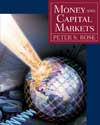 |  Money and Capital Markets: Financial Institutions and Instruments in a Global Marketplace, 8/e Peter Rose,
Texas A & M University
The Residential Mortgage Market
Chapter SummaryThis chapter has focused on one of the most important markets in the financial system—
the market for residential mortgage credit.
- Home ownership has grown in importance in recent years with a record number of individuals
and families in the United States today (about two-thirds) owning their own
homes. The value of homes as a tax-reducing investment and as a hedge against inflation
has played a major role in this home ownership trend as has the drive toward more lenient
borrowing terms, encouraged by government support of the home mortgage market.
- Among the leading home mortgage lending institutions today are commercial banks,
savings banks and savings and loan associations, life insurance companies, and mortgage
banking firms.
- U.S. federal government intervention in the home mortgage market began in earnest
during the 1930s and 1940s with the creation of several major federal agencies, including
the Federal Housing Administration (FHA), the Federal National Mortgage Association
(FNMA), the Veterans Administration (VA), and the Government National
Mortgage Association (GNMA). These agencies were directed to expand the supply of
mortgage credit available and to make mortgages more affordable for a greater proportion
of the U.S. population. This was accomplished through such devices as guaranteeing
the repayment of selected home mortgages (through FHA and VA) and creating an
active resale market for existing home loans (through FNMA and GNMA).
- Later the Federal Home Loan Mortgage Corporation (FHLMC) was created to assist in
expanding the supply of home mortgage credit and to aid in the development of security-like
mortgage instruments to broaden and deepen the market for mortgage credit.
- Among the most important of new mortgage-related securities developed in recent years
to expand the depth and breadth of the residential mortgage market are mortgage-backed
securities, collateralized mortgage obligations (CMOs), and real estate mortgage
investment conduits (REMICs). Each is based on the notion of pooling together a group
of similar home mortgage loans and issuing securities against that pool that will eventually
be paid off by the cash flow (principal and interest payments) generated from the
loans in the pool.
- Mortgage-loan-backed security instruments have been used to attract millions of new
investors to the home mortgage market and to increase the liquidity of mortgage instruments.
Securitized mortgage instruments have helped make the market for home mortgages
a global capital market rather than a regionally isolated marketplace as it was
before their invention.
- In order to encourage individuals and families to consider home ownership many new
home mortgage loans and other home financing devices have been developed, some of
them making mortgage credit available on more lenient and affordable terms. Examples
include variable-rate mortgages (VRMs), adjustable mortgage instruments (AMIs), convertible
mortgages, reverse annuity mortgages, home equity loans, and home mortgage
refinancings.
- The home mortgage market today has become one of the largest markets for a single financial
instrument on the planet. It has helped to make U.S. citizens among the best-housed
individuals in the world and in the process has interconnected the market for
home loans with those for Treasury bonds, state and local government bonds, and corporate
bonds and notes. No longer are mortgage-related instruments insensitive to the
broad market trends that affect the global money and capital markets today.
|
|




 2003 McGraw-Hill Higher Education
2003 McGraw-Hill Higher Education